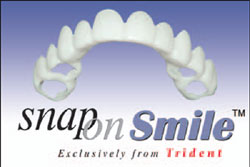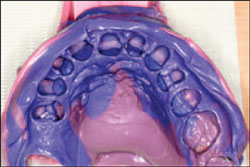Cosmetic Alternative to Permanent Dental Work: The Snap-On Smile™
Dr.Marc Liechtung
Cosmetic and restorative dentistry has encompassed many different modalities of treatment. Since 1987 we have seen such innovative dental growth as porcelain veneers, full-coverage crowns, and laser bleaching. This article profiles the development of a new modality known as the Snap-On Smile™ and will show how this new appliance served as a restoration for a patient who may not have agreed to any other form of treatment.
Addressing a Patient’s Fear of the “Unknown”
A 52-year-old male presented to the author’s office for treatment regarding 2 issues in his oral cavity. This patient’s chief complaint was that he felt his facial height was sinking, and it was starting to bother him. He was told by previous dentists that he was a grinder, or a bruxer. The second complaint, even more pressing to him, was that he looked as if he was toothless when he smiled (Figure 1). It was explained to him this was a problem resulting from his primary complaint. Both issues were related, which the patient did not know, and by caring or at least addressing one, it would be possible to accomplish a great improvement in regard to the other.
After taking x-rays, the different treatment options available were discussed at length. These options included everything from a night guard, which did not address his cosmetic component, to restoring his facial height using full mouth rehabilitation via conventional restorative dentistry. The avenues of treatment given were options that the patient was not ready to accept for a variety of reasons. Some of the options addressed only part of his complaints, leaving some complaints untouched. Although most of his treatment solutions did contain a financial burden, his chief concern was what he called the “unknown factor”—how would he look and feel after such extensive treatment was completed? Along with not knowing the end results, drilling down his teeth may lead to further dental treatment down the road. He was left searching for another option that would allow him to cure his complaints without causing permanent changes, and at a less costly toll.
The Snap-On Smile Alternative
About 14 months prior to this patient’s visit, the author created and patented an appliance made out of an acetyl resin that utilized the contours of natural dentition for retention (Figure 2). This appliance is called the Snap-On Smile because it literally snaps over a patient’s teeth because of the material’s unique memory properties. Because it does not require bonding agents or drilling to adhere it to the teeth, patients are informed that this option is removable. And with 19 different shades that the author created with the manufacturer of the resin, the Snap-On Smile also creates a beautiful smile. After several months of using the Snap-On Smile, the author has found that the only contraindication is a patient with severe, highly mobile, periodontally diseased teeth. Having successfully treated several hundred patients with this appliance, and accomplishing tremendous results, the author believed that this would be a fantastic option in this case of a severe bruxer who needed cosmetic enhancement as well.
After presenting the positives and negatives to the patient, he was extremely eager to be treated without any injections or administration of anesthesia. He was also pleased to hear that the only work performed would be taking 2 accurate impressions of both the upper and lower arches. In less than an hour and only 2 appointments, the patient would achieve a similar look to that of any other cosmetic treatment but at a fraction of cost.
The Process
Impressions were taken using stock trays with a polyether impression material and an accurate bite registration (Figure 3). A polyether or polyvinyl siloxane is recommended for a number of reasons, such as the gingival margins of all the teeth and the heights of contour need to be registered accurately, and the staying power of this material allows for the time involved with sending the case to the lab. Since there is only 1 lab licensed and trained to do a Snap-On Smile (Trident Dental Laboratories, Hawthorne, CA), the polyether or polyvinyl siloxane materials should be used in order to maintain durability. After the impressions, time was spent allowing the patient to express his cosmetic concerns and desires for his new smile, such as shape, length, and, of course, shade. A photo was taken to allow the technicians to have better knowledge of the case, which is something that is imperative for any and all cosmetic cases. Finally, the case was sent to Trident Labs for fabrication of an upper and lower Snap-On Smile appliance.
After 10 days the Snap-On Smile was returned and was ready to insert. Upon the first insertion, the patient was informed that there would be a slight tightness around his teeth that would subside in approximately 30 minutes, and in some cases this may take longer. Also, the tongue takes some time to become phonetically comfortable, but for this patient, he seemed comfortable from the moment the appliances were placed in his mouth. Cosmetically, the results were immediate, although at first the increase in vertical dimension was slightly strange to the patient; however, he quickly adapted and was amazed and delighted at the esthetics (Figure 4). After wearing the appliances for several months, the patient is less apprehensive and considering going to fixed restorations for both his upper and lower arches.
Conclusion
This article presented a case that shows the importance and versatility that the Snap-On Smile appliance will have in dentistry for many years to come. This is a treatment option that should be included in every dentist’s case presentation when discussing treatment planning with a patient. It allows a patient to never have to leave the office without accepting some form of treatment, which will help dentists in their practice-building efforts. The end results can aid as a diagnostic tool in the dentist’s ability to ultimately deliver more predictable and more acceptable permanent dentistry. More importantly, this option can be a tremendous help in restoring not only oral health but a patient’s confidence in dentistry as well. The Snap-On Smile will allow clinicians to expand cosmetic and restorative dentistry’s modalities even further than has been done today.
For More Information
Trident Dental Laboratories
Phone: 1-800-221-4831
Web: www.tridentlab.com
 Figure 1 Pretreatment photos of patient who was concerned about a toothless smile and sinking facial height. |
 |
| Figure 2 The Snap-On Smile utilizes the contours of natural dentition for retention. Occlusal holes allow patients to chew. | |
 Figure 3 An impression is taken using polyether or polyvinyl siloxane material. |
 Figure 4 The Snap-On Smile appliance has been placed and the patient is pleased with the results. |



